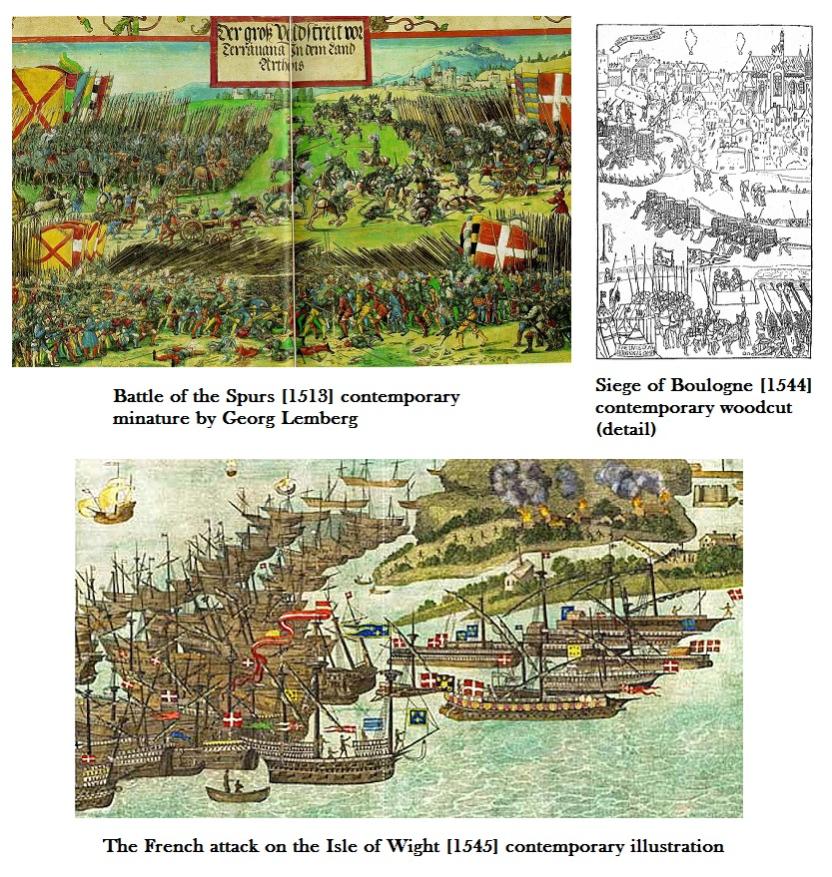THE ROSE & THE LILY – HENRY VIII’S WARS WITH FRANCE
Besides continuing the Tudor dynasty founded by his father, Henry VIII had one overriding ambition: to restore England’s French territories lost during the Hundred Years War [1337-1453]. By the time of his accession in 1509, England’s only French possession was the port of Calais but Henry was determined to rebuild his Plantagenet ancestors’ empire, which once stretched from The English Channel to The Pyrenees…
1511 - In the hope of recovering Aquitaine, Henry forms an alliance with Ferdinand King of Spain and joins Pope Julius II’s anti-French Holy League. The pope grants Henry the title ‘Most Christian King of France’ and promises to crown Henry in person if the French are defeated.
1512 - An Anglo-Spanish invasion of South Western France is an utter failure but Henry manages to persuade the Holy Roman Emperor Maximilian to join the war against France.
1513 – Henry invades France, defeats the French at the Battle of the Spurs and captures several important towns including Tournai. In response, the French activate their ‘Auld Alliance’ with Scotland; the Scots dutifully invade Northern England but are annihilated at the Battle of Flodden.
1514 – The death of Pope Julius means Henry’s dreams of conquering France by the sword have to be postponed. Henry concludes a peace treaty with the ageing French King Louis XII who marries Henry’s young sister Mary.
1515 - Henry’s scheme to win France through a dynastic alliance fails when Louis dies without giving Mary a son. The French throne passes to Louis’ cousin Francis but Henry does not renew the war for another nine years.
1519 – Holy Roman Emperor Maximilian dies. Both Henry and Francis campaign to be elected his successor but the winner is Maximilian’s grandson Charles V, who is also King of Spain and King of Italy. France is now surrounded by Charles’ domains, so Francis tries to detach Henry from his imperial alliances.
1520 – Henry meets Francis at the Field of the Cloth of Gold. The two weeks of jousts and feasting seem to herald a new warmth between England and France.
1521 – Francis attacks Charles’ territories in Flanders, Navarre and Italy but Henry, who is married the Emperor Charles’s aunt Catherine of Aragon, seizes this opportunity to revive his dreams of conquest and joins his imperial nephew.
1522 – Henry signs the Treaty of Westminster whereby he agrees to invade France in support of Charles and the imperial cause.
1523 – An English army marches on Paris but the campaign is a fiasco. Fifty miles from the French capital, Henry’s troops mutiny and desert en masse. Despite this failure, Henry continues to send gold to Charles to fund his ally’s mercenary armies.
1525 – Charles defeats Francis at the Battle of Pavia but Henry does not benefit from the imperial victory. Facing bankruptcy, Henry signs the Treaty of the More with the French, whereby he agrees to surrender some of his claims to Francis’ territory in exchange for an annual payment of £20,000.
1527 – As Henry’s resolve to divorce Catherine of Aragon strengthens, he swaps sides and joins the French King Francis, the Pope and Venice in the anti-imperial League of Cognac. However the new war against Charles ends in another ignominious defeat for Francis.
1529 – Francis abandons his ally Henry and signs the Treaty of Cambrai (also known as the Paix des Dames as it was negotiated by Francis’ mother Louise of Savoy and Charles’ aunt Margaret of Austria). Once again Henry’s dreams of empire lie in ruins.
1539 – With Catherine of Aragon and Anne Boleyn now dead, relations between England and the Holy Roman Empire improve. Henry agrees to support Charles in his renewal of the war with France but he will not commit to fighting on the continent until the threat from Scotland is neutralised.
1542 – Henry defeats the Scots at the Battle of Solway Moss and tries to use military force to persuade the Scottish heiress Mary (Queen of Scots) to marry his son Edward. This is known as the Rough Wooing.
1544 – Henry finally honours his treaty with Charles and invades France. An English army, led in person by Henry, captures Boulogne but Charles suddenly makes a separate peace with France. Henry is left to fight on alone.
1545 – Francis tries to invade England but is defeated. Henry’s flagship, the Mary Rose, capsizes and sinks whilst leading an attack against the French galleys trying to land troops on the Isle of Wight.
1547 – Death of Henry VIII.
POSTSCRIPT - Henry’s son Edward VI was forced to abandon Boulogne in 1550 whilst his daughter Mary I had to surrender Calais in 1558. However British monarchs continued to style themselves ‘King (or Queen) of France’ until the French Revolution abolished the monarchy. The French fleur-de-lys were finally removed from the English royal standard in 1802!
